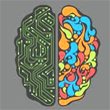Monday, 18 August 2014
The myth of left-brained and right-brained personalities

One often reads that certain functions of the human brain are lateralized—for example, that the left hemisphere is more involved in language and the right in the processing of visuospatial information. One also often hears it said that some people are left-brained (meaning that they are analytical, logical, and focused on details) while others are right-brained (more subjective and creative, with more of a tendency to see things as a whole).
But according to a study published on August 14, 2013 in the online journal PLOS ONE, although there is abundant evidence for the lateralization of certain brain functions, the idea of left-brained and right-brained personalities is simply a myth. When the authors of this study used resting-state functional magnetic resonance imaging scans of the brains of 1011 individuals to analyze brain connectivity, they did not find any greater connectivity in one hemisphere or the other for any given individuals.
One of the authors of this study, Jeffrey Anderson, points out that in most right-handed people, one can readily observe greater activation of regions in the left hemisphere of the brain when a language-related stimulus is presented (although some regions of the right hemisphere are also activated by certain aspects of language, such as intonation). Similarly, visuospatial stimuli will activate more regions in the right hemisphere. However, according to Anderson, the data in this study do not support the left-brain/right-brain distinction that crops up so often in popular culture.
Instead, when Anderson and his colleagues subdivided the brain images in their study into more than 7000 subregions, then statistically analyzed the activity correlations among these subregions, they found 9 richly interconnected networks in the left hemisphere and 11 in the right. The ones in the left hemisphere included regions from the default-mode network and language regions, while the ones in the right hemisphere included regions from the attention-control network.
Thus this study clearly shows some independent neuronal networks that are lateralized in the brain, but no tendency for particular individuals to show a stronger overall lateralization of brain connectivity in one hemisphere or the other. It would therefore appear that if the personality traits traditionally associated with “left-brained” people or “right-brained” people really do constitute a coherent whole, then their neuronal basis must be on a smaller scale than that of the two hemispheres.
![]() Researchers Debunk Myth of“Right-Brained” and “Left-Brained” Personality Traits
Researchers Debunk Myth of“Right-Brained” and “Left-Brained” Personality Traits
![]() An Evaluation of the Left-Brain vs. Right-Brain Hypothesis with Resting State Functional Connectivity Magnetic Resonance Imaging
An Evaluation of the Left-Brain vs. Right-Brain Hypothesis with Resting State Functional Connectivity Magnetic Resonance Imaging
![]() Why The Left-Brain Right-Brain Myth Will Probably Never Die
Why The Left-Brain Right-Brain Myth Will Probably Never Die
From Thought to Language | Comments Closed







